Institute of Technology Carlow Disability Studies Essay
VerifiedAdded on 2022/11/01
|9
|2170
|181
Essay
AI Summary
This essay, submitted by a student, delves into the field of Disability Studies, focusing on a specific client group: working-age individuals with disabilities. It begins by defining disability and providing statistical context from Irish census data, highlighting the challenges faced by this group, including employment disparities, educational attainment, and accessibility issues. The essay then explores the Theory of Change for Inclusion Ireland, illustrating how societal barriers lead to exclusion and the importance of community integration. It emphasizes the role of social care workers in advocating for equality, maximizing participation, and promoting inclusion through various strategies, such as providing decision-making power and addressing transport and allowance issues. The essay concludes by underscoring the relevance of Disability Studies in fostering understanding and appreciation for all individuals, regardless of ability, and includes a comprehensive bibliography of cited sources.
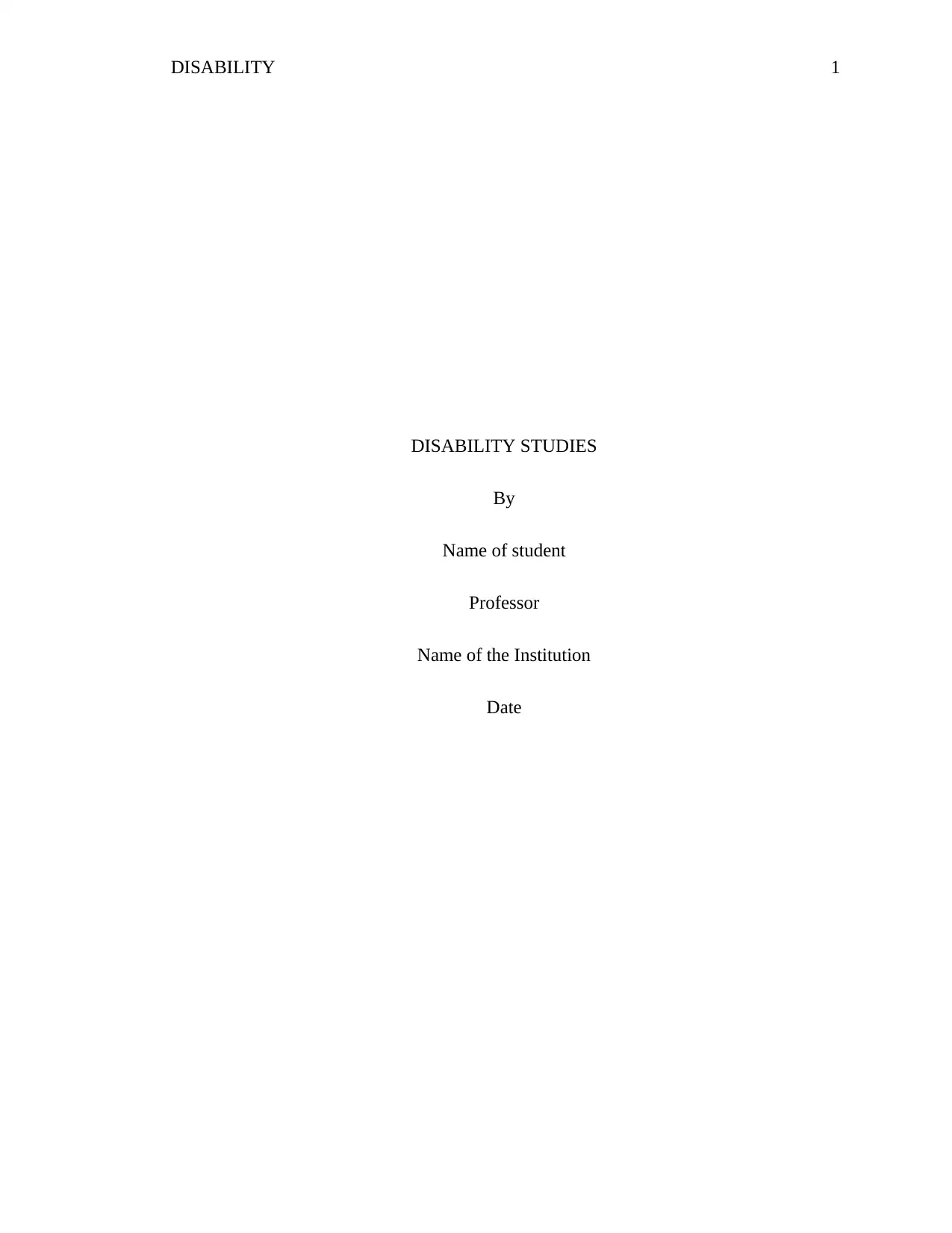
DISABILITY 1
DISABILITY STUDIES
By
Name of student
Professor
Name of the Institution
Date
DISABILITY STUDIES
By
Name of student
Professor
Name of the Institution
Date
Paraphrase This Document
Need a fresh take? Get an instant paraphrase of this document with our AI Paraphraser
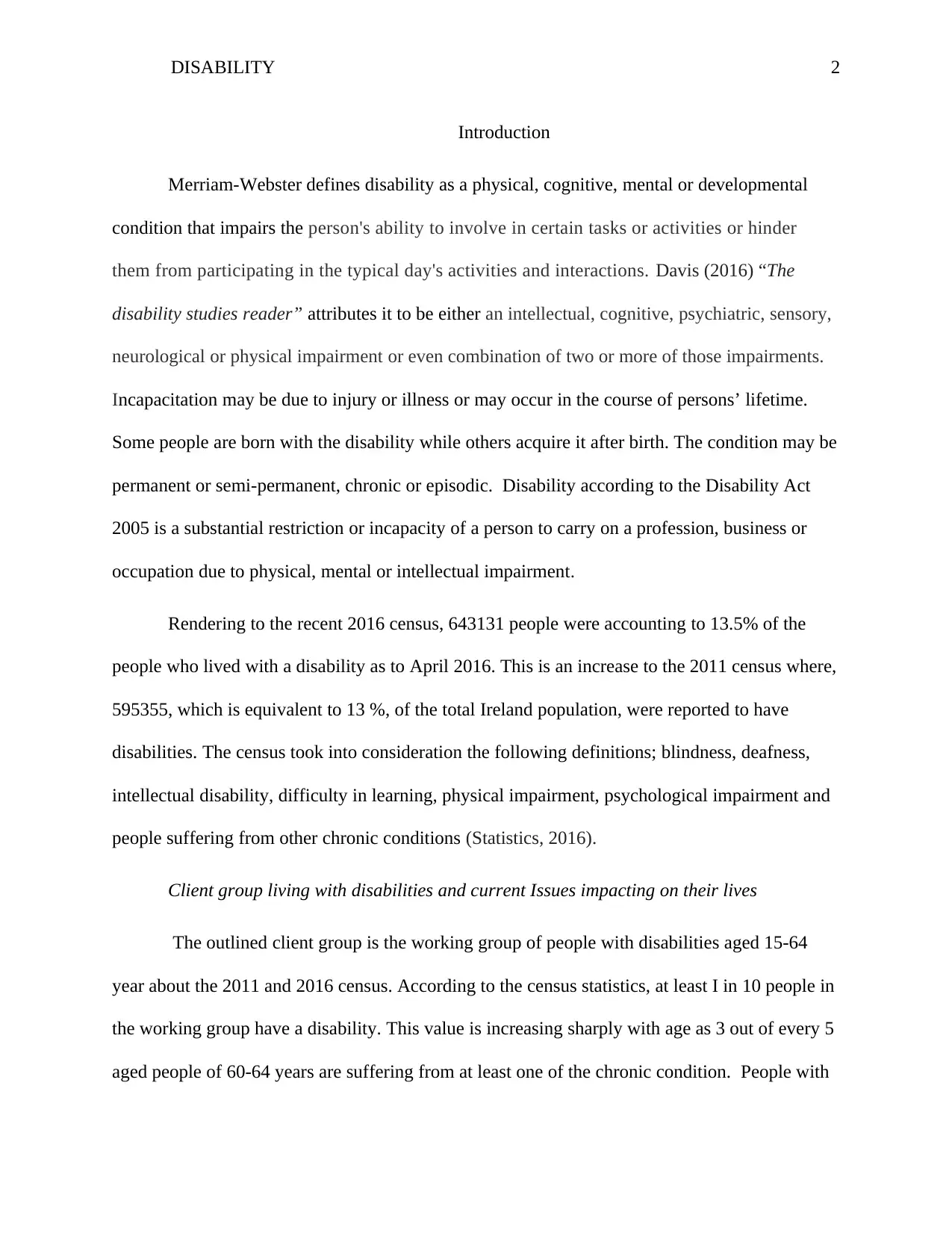
DISABILITY 2
Introduction
Merriam-Webster defines disability as a physical, cognitive, mental or developmental
condition that impairs the person's ability to involve in certain tasks or activities or hinder
them from participating in the typical day's activities and interactions. Davis (2016) “The
disability studies reader” attributes it to be either an intellectual, cognitive, psychiatric, sensory,
neurological or physical impairment or even combination of two or more of those impairments.
Incapacitation may be due to injury or illness or may occur in the course of persons’ lifetime.
Some people are born with the disability while others acquire it after birth. The condition may be
permanent or semi-permanent, chronic or episodic. Disability according to the Disability Act
2005 is a substantial restriction or incapacity of a person to carry on a profession, business or
occupation due to physical, mental or intellectual impairment.
Rendering to the recent 2016 census, 643131 people were accounting to 13.5% of the
people who lived with a disability as to April 2016. This is an increase to the 2011 census where,
595355, which is equivalent to 13 %, of the total Ireland population, were reported to have
disabilities. The census took into consideration the following definitions; blindness, deafness,
intellectual disability, difficulty in learning, physical impairment, psychological impairment and
people suffering from other chronic conditions (Statistics, 2016).
Client group living with disabilities and current Issues impacting on their lives
The outlined client group is the working group of people with disabilities aged 15-64
year about the 2011 and 2016 census. According to the census statistics, at least I in 10 people in
the working group have a disability. This value is increasing sharply with age as 3 out of every 5
aged people of 60-64 years are suffering from at least one of the chronic condition. People with
Introduction
Merriam-Webster defines disability as a physical, cognitive, mental or developmental
condition that impairs the person's ability to involve in certain tasks or activities or hinder
them from participating in the typical day's activities and interactions. Davis (2016) “The
disability studies reader” attributes it to be either an intellectual, cognitive, psychiatric, sensory,
neurological or physical impairment or even combination of two or more of those impairments.
Incapacitation may be due to injury or illness or may occur in the course of persons’ lifetime.
Some people are born with the disability while others acquire it after birth. The condition may be
permanent or semi-permanent, chronic or episodic. Disability according to the Disability Act
2005 is a substantial restriction or incapacity of a person to carry on a profession, business or
occupation due to physical, mental or intellectual impairment.
Rendering to the recent 2016 census, 643131 people were accounting to 13.5% of the
people who lived with a disability as to April 2016. This is an increase to the 2011 census where,
595355, which is equivalent to 13 %, of the total Ireland population, were reported to have
disabilities. The census took into consideration the following definitions; blindness, deafness,
intellectual disability, difficulty in learning, physical impairment, psychological impairment and
people suffering from other chronic conditions (Statistics, 2016).
Client group living with disabilities and current Issues impacting on their lives
The outlined client group is the working group of people with disabilities aged 15-64
year about the 2011 and 2016 census. According to the census statistics, at least I in 10 people in
the working group have a disability. This value is increasing sharply with age as 3 out of every 5
aged people of 60-64 years are suffering from at least one of the chronic condition. People with
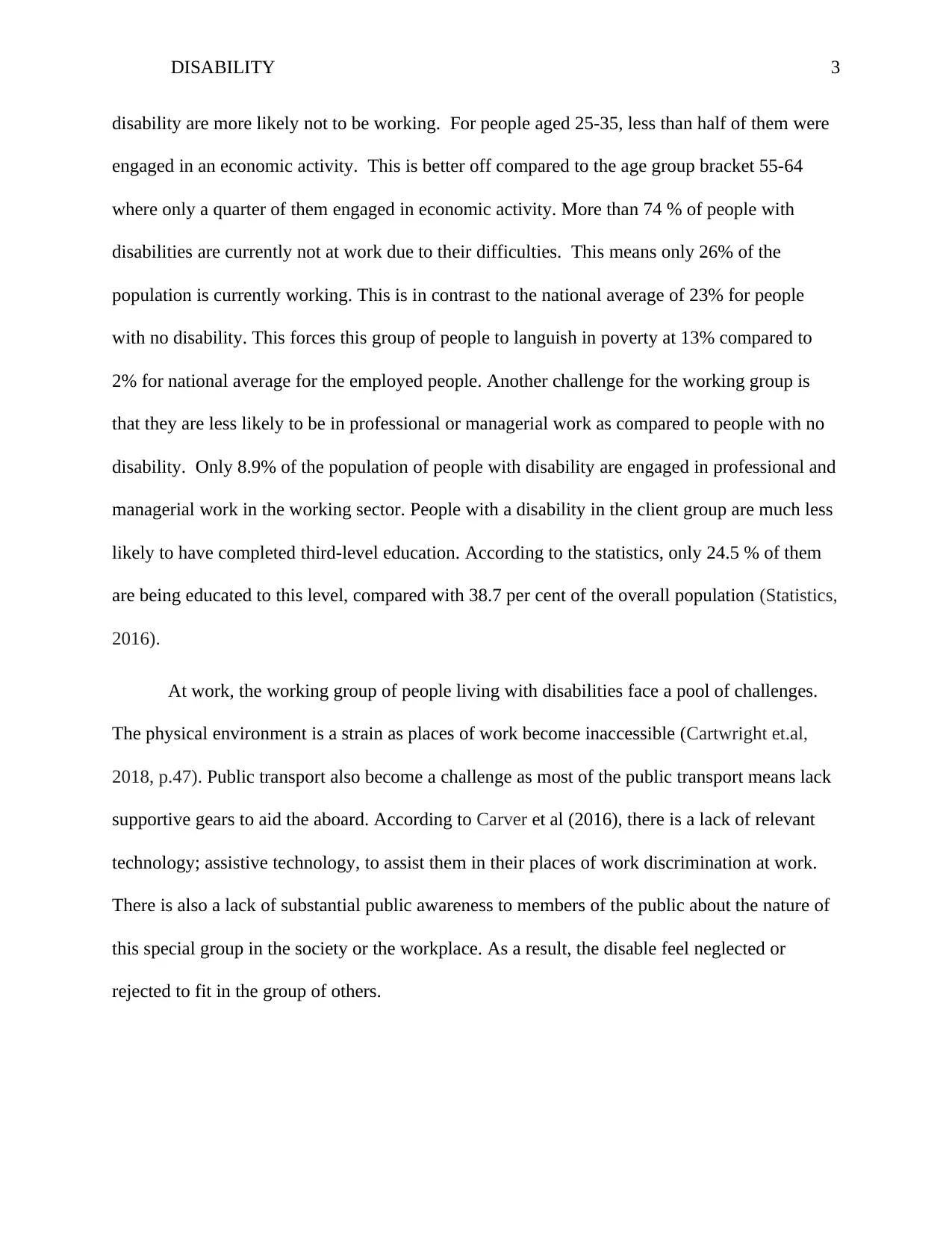
DISABILITY 3
disability are more likely not to be working. For people aged 25-35, less than half of them were
engaged in an economic activity. This is better off compared to the age group bracket 55-64
where only a quarter of them engaged in economic activity. More than 74 % of people with
disabilities are currently not at work due to their difficulties. This means only 26% of the
population is currently working. This is in contrast to the national average of 23% for people
with no disability. This forces this group of people to languish in poverty at 13% compared to
2% for national average for the employed people. Another challenge for the working group is
that they are less likely to be in professional or managerial work as compared to people with no
disability. Only 8.9% of the population of people with disability are engaged in professional and
managerial work in the working sector. People with a disability in the client group are much less
likely to have completed third-level education. According to the statistics, only 24.5 % of them
are being educated to this level, compared with 38.7 per cent of the overall population (Statistics,
2016).
At work, the working group of people living with disabilities face a pool of challenges.
The physical environment is a strain as places of work become inaccessible (Cartwright et.al,
2018, p.47). Public transport also become a challenge as most of the public transport means lack
supportive gears to aid the aboard. According to Carver et al (2016), there is a lack of relevant
technology; assistive technology, to assist them in their places of work discrimination at work.
There is also a lack of substantial public awareness to members of the public about the nature of
this special group in the society or the workplace. As a result, the disable feel neglected or
rejected to fit in the group of others.
disability are more likely not to be working. For people aged 25-35, less than half of them were
engaged in an economic activity. This is better off compared to the age group bracket 55-64
where only a quarter of them engaged in economic activity. More than 74 % of people with
disabilities are currently not at work due to their difficulties. This means only 26% of the
population is currently working. This is in contrast to the national average of 23% for people
with no disability. This forces this group of people to languish in poverty at 13% compared to
2% for national average for the employed people. Another challenge for the working group is
that they are less likely to be in professional or managerial work as compared to people with no
disability. Only 8.9% of the population of people with disability are engaged in professional and
managerial work in the working sector. People with a disability in the client group are much less
likely to have completed third-level education. According to the statistics, only 24.5 % of them
are being educated to this level, compared with 38.7 per cent of the overall population (Statistics,
2016).
At work, the working group of people living with disabilities face a pool of challenges.
The physical environment is a strain as places of work become inaccessible (Cartwright et.al,
2018, p.47). Public transport also become a challenge as most of the public transport means lack
supportive gears to aid the aboard. According to Carver et al (2016), there is a lack of relevant
technology; assistive technology, to assist them in their places of work discrimination at work.
There is also a lack of substantial public awareness to members of the public about the nature of
this special group in the society or the workplace. As a result, the disable feel neglected or
rejected to fit in the group of others.
⊘ This is a preview!⊘
Do you want full access?
Subscribe today to unlock all pages.

Trusted by 1+ million students worldwide
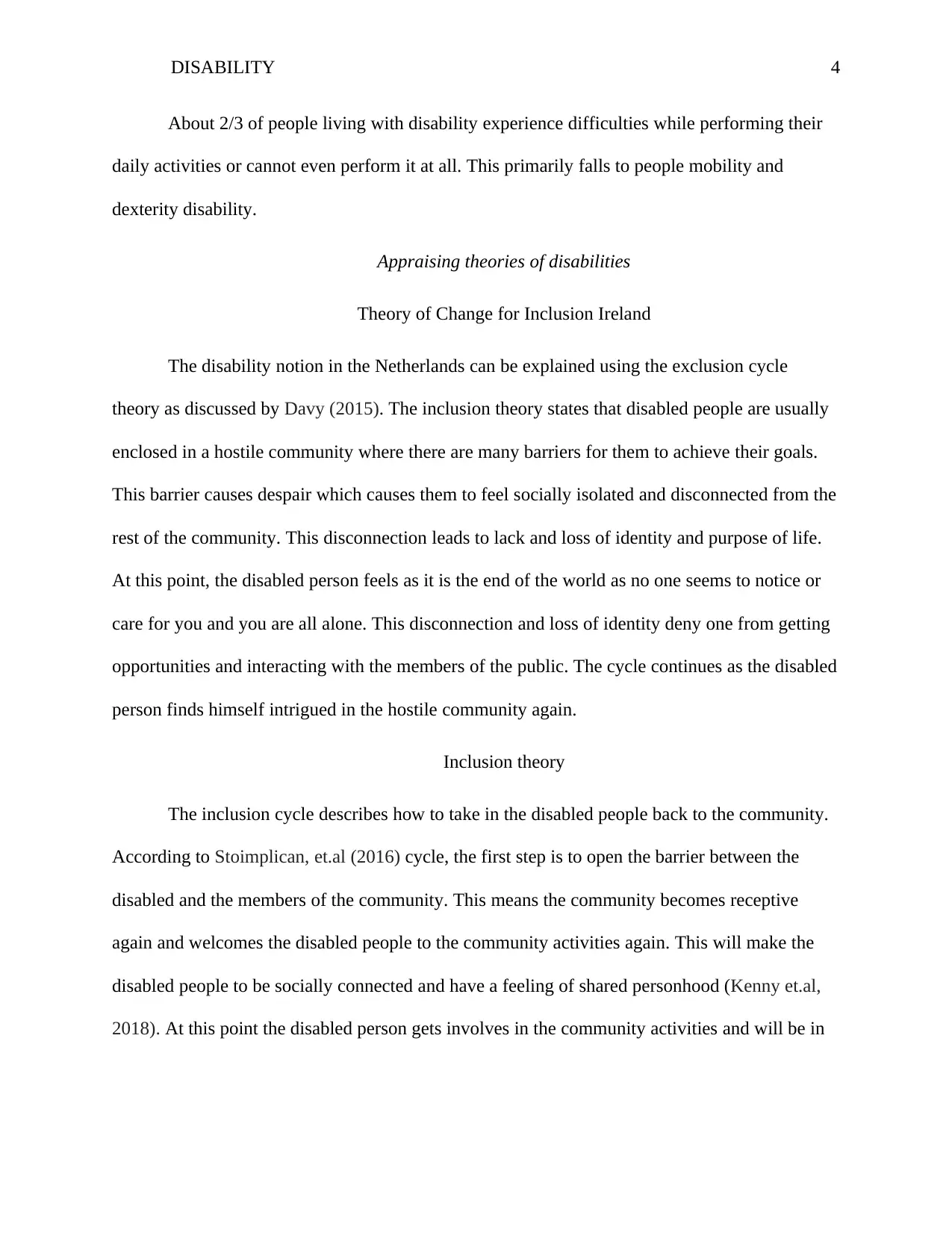
DISABILITY 4
About 2/3 of people living with disability experience difficulties while performing their
daily activities or cannot even perform it at all. This primarily falls to people mobility and
dexterity disability.
Appraising theories of disabilities
Theory of Change for Inclusion Ireland
The disability notion in the Netherlands can be explained using the exclusion cycle
theory as discussed by Davy (2015). The inclusion theory states that disabled people are usually
enclosed in a hostile community where there are many barriers for them to achieve their goals.
This barrier causes despair which causes them to feel socially isolated and disconnected from the
rest of the community. This disconnection leads to lack and loss of identity and purpose of life.
At this point, the disabled person feels as it is the end of the world as no one seems to notice or
care for you and you are all alone. This disconnection and loss of identity deny one from getting
opportunities and interacting with the members of the public. The cycle continues as the disabled
person finds himself intrigued in the hostile community again.
Inclusion theory
The inclusion cycle describes how to take in the disabled people back to the community.
According to Stoimplican, et.al (2016) cycle, the first step is to open the barrier between the
disabled and the members of the community. This means the community becomes receptive
again and welcomes the disabled people to the community activities again. This will make the
disabled people to be socially connected and have a feeling of shared personhood (Kenny et.al,
2018). At this point the disabled person gets involves in the community activities and will be in
About 2/3 of people living with disability experience difficulties while performing their
daily activities or cannot even perform it at all. This primarily falls to people mobility and
dexterity disability.
Appraising theories of disabilities
Theory of Change for Inclusion Ireland
The disability notion in the Netherlands can be explained using the exclusion cycle
theory as discussed by Davy (2015). The inclusion theory states that disabled people are usually
enclosed in a hostile community where there are many barriers for them to achieve their goals.
This barrier causes despair which causes them to feel socially isolated and disconnected from the
rest of the community. This disconnection leads to lack and loss of identity and purpose of life.
At this point, the disabled person feels as it is the end of the world as no one seems to notice or
care for you and you are all alone. This disconnection and loss of identity deny one from getting
opportunities and interacting with the members of the public. The cycle continues as the disabled
person finds himself intrigued in the hostile community again.
Inclusion theory
The inclusion cycle describes how to take in the disabled people back to the community.
According to Stoimplican, et.al (2016) cycle, the first step is to open the barrier between the
disabled and the members of the community. This means the community becomes receptive
again and welcomes the disabled people to the community activities again. This will make the
disabled people to be socially connected and have a feeling of shared personhood (Kenny et.al,
2018). At this point the disabled person gets involves in the community activities and will be in
Paraphrase This Document
Need a fresh take? Get an instant paraphrase of this document with our AI Paraphraser
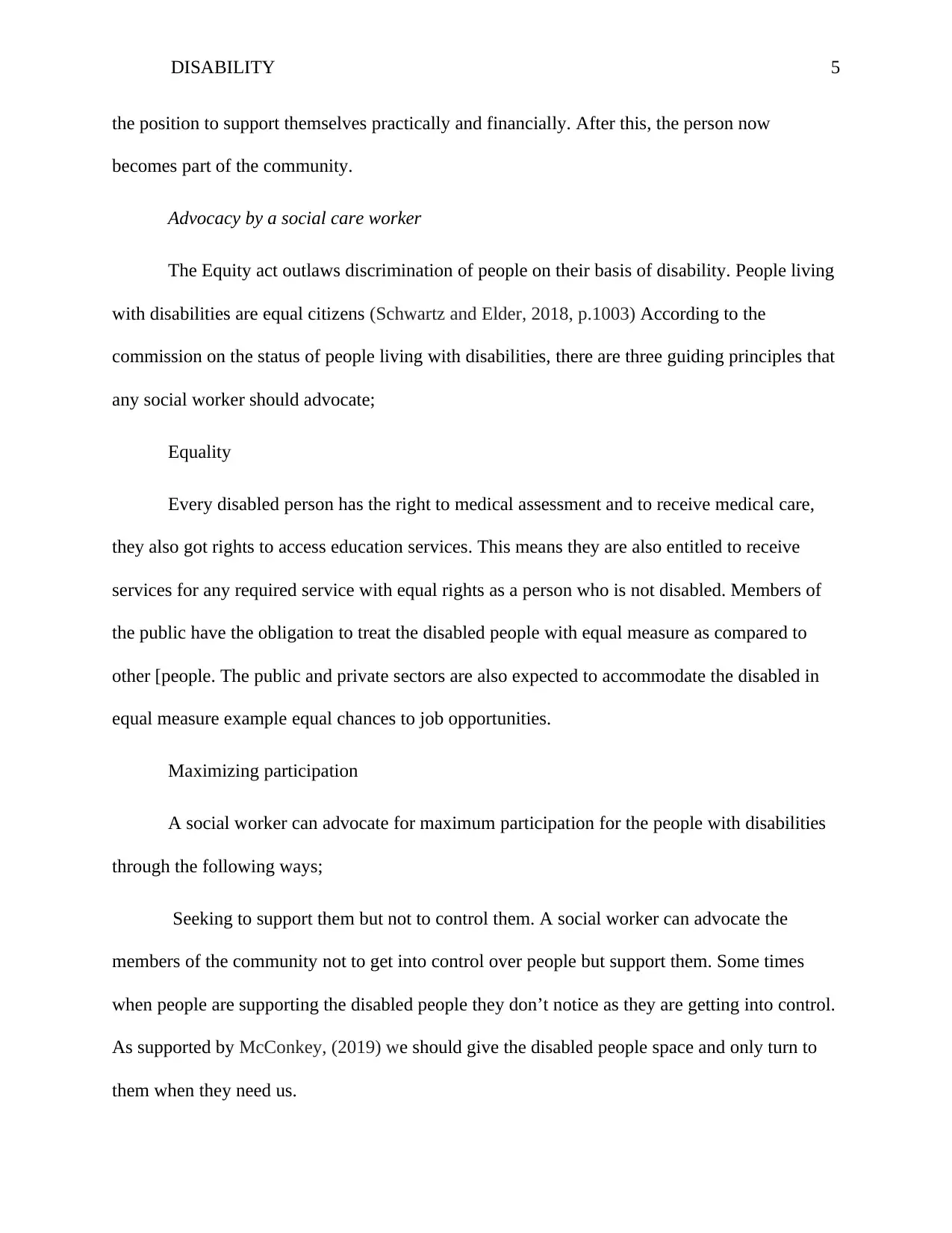
DISABILITY 5
the position to support themselves practically and financially. After this, the person now
becomes part of the community.
Advocacy by a social care worker
The Equity act outlaws discrimination of people on their basis of disability. People living
with disabilities are equal citizens (Schwartz and Elder, 2018, p.1003) According to the
commission on the status of people living with disabilities, there are three guiding principles that
any social worker should advocate;
Equality
Every disabled person has the right to medical assessment and to receive medical care,
they also got rights to access education services. This means they are also entitled to receive
services for any required service with equal rights as a person who is not disabled. Members of
the public have the obligation to treat the disabled people with equal measure as compared to
other [people. The public and private sectors are also expected to accommodate the disabled in
equal measure example equal chances to job opportunities.
Maximizing participation
A social worker can advocate for maximum participation for the people with disabilities
through the following ways;
Seeking to support them but not to control them. A social worker can advocate the
members of the community not to get into control over people but support them. Some times
when people are supporting the disabled people they don’t notice as they are getting into control.
As supported by McConkey, (2019) we should give the disabled people space and only turn to
them when they need us.
the position to support themselves practically and financially. After this, the person now
becomes part of the community.
Advocacy by a social care worker
The Equity act outlaws discrimination of people on their basis of disability. People living
with disabilities are equal citizens (Schwartz and Elder, 2018, p.1003) According to the
commission on the status of people living with disabilities, there are three guiding principles that
any social worker should advocate;
Equality
Every disabled person has the right to medical assessment and to receive medical care,
they also got rights to access education services. This means they are also entitled to receive
services for any required service with equal rights as a person who is not disabled. Members of
the public have the obligation to treat the disabled people with equal measure as compared to
other [people. The public and private sectors are also expected to accommodate the disabled in
equal measure example equal chances to job opportunities.
Maximizing participation
A social worker can advocate for maximum participation for the people with disabilities
through the following ways;
Seeking to support them but not to control them. A social worker can advocate the
members of the community not to get into control over people but support them. Some times
when people are supporting the disabled people they don’t notice as they are getting into control.
As supported by McConkey, (2019) we should give the disabled people space and only turn to
them when they need us.
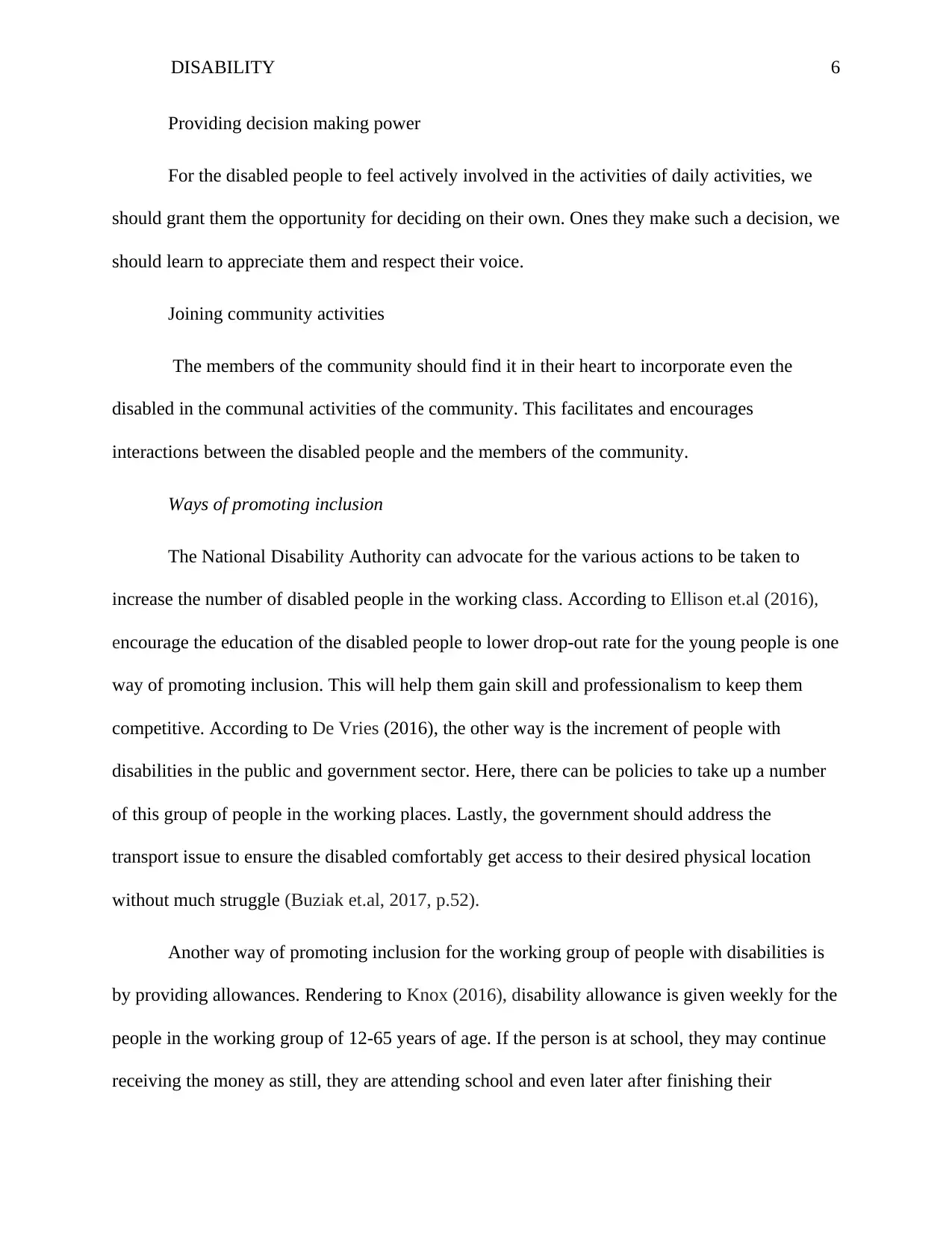
DISABILITY 6
Providing decision making power
For the disabled people to feel actively involved in the activities of daily activities, we
should grant them the opportunity for deciding on their own. Ones they make such a decision, we
should learn to appreciate them and respect their voice.
Joining community activities
The members of the community should find it in their heart to incorporate even the
disabled in the communal activities of the community. This facilitates and encourages
interactions between the disabled people and the members of the community.
Ways of promoting inclusion
The National Disability Authority can advocate for the various actions to be taken to
increase the number of disabled people in the working class. According to Ellison et.al (2016),
encourage the education of the disabled people to lower drop-out rate for the young people is one
way of promoting inclusion. This will help them gain skill and professionalism to keep them
competitive. According to De Vries (2016), the other way is the increment of people with
disabilities in the public and government sector. Here, there can be policies to take up a number
of this group of people in the working places. Lastly, the government should address the
transport issue to ensure the disabled comfortably get access to their desired physical location
without much struggle (Buziak et.al, 2017, p.52).
Another way of promoting inclusion for the working group of people with disabilities is
by providing allowances. Rendering to Knox (2016), disability allowance is given weekly for the
people in the working group of 12-65 years of age. If the person is at school, they may continue
receiving the money as still, they are attending school and even later after finishing their
Providing decision making power
For the disabled people to feel actively involved in the activities of daily activities, we
should grant them the opportunity for deciding on their own. Ones they make such a decision, we
should learn to appreciate them and respect their voice.
Joining community activities
The members of the community should find it in their heart to incorporate even the
disabled in the communal activities of the community. This facilitates and encourages
interactions between the disabled people and the members of the community.
Ways of promoting inclusion
The National Disability Authority can advocate for the various actions to be taken to
increase the number of disabled people in the working class. According to Ellison et.al (2016),
encourage the education of the disabled people to lower drop-out rate for the young people is one
way of promoting inclusion. This will help them gain skill and professionalism to keep them
competitive. According to De Vries (2016), the other way is the increment of people with
disabilities in the public and government sector. Here, there can be policies to take up a number
of this group of people in the working places. Lastly, the government should address the
transport issue to ensure the disabled comfortably get access to their desired physical location
without much struggle (Buziak et.al, 2017, p.52).
Another way of promoting inclusion for the working group of people with disabilities is
by providing allowances. Rendering to Knox (2016), disability allowance is given weekly for the
people in the working group of 12-65 years of age. If the person is at school, they may continue
receiving the money as still, they are attending school and even later after finishing their
⊘ This is a preview!⊘
Do you want full access?
Subscribe today to unlock all pages.

Trusted by 1+ million students worldwide
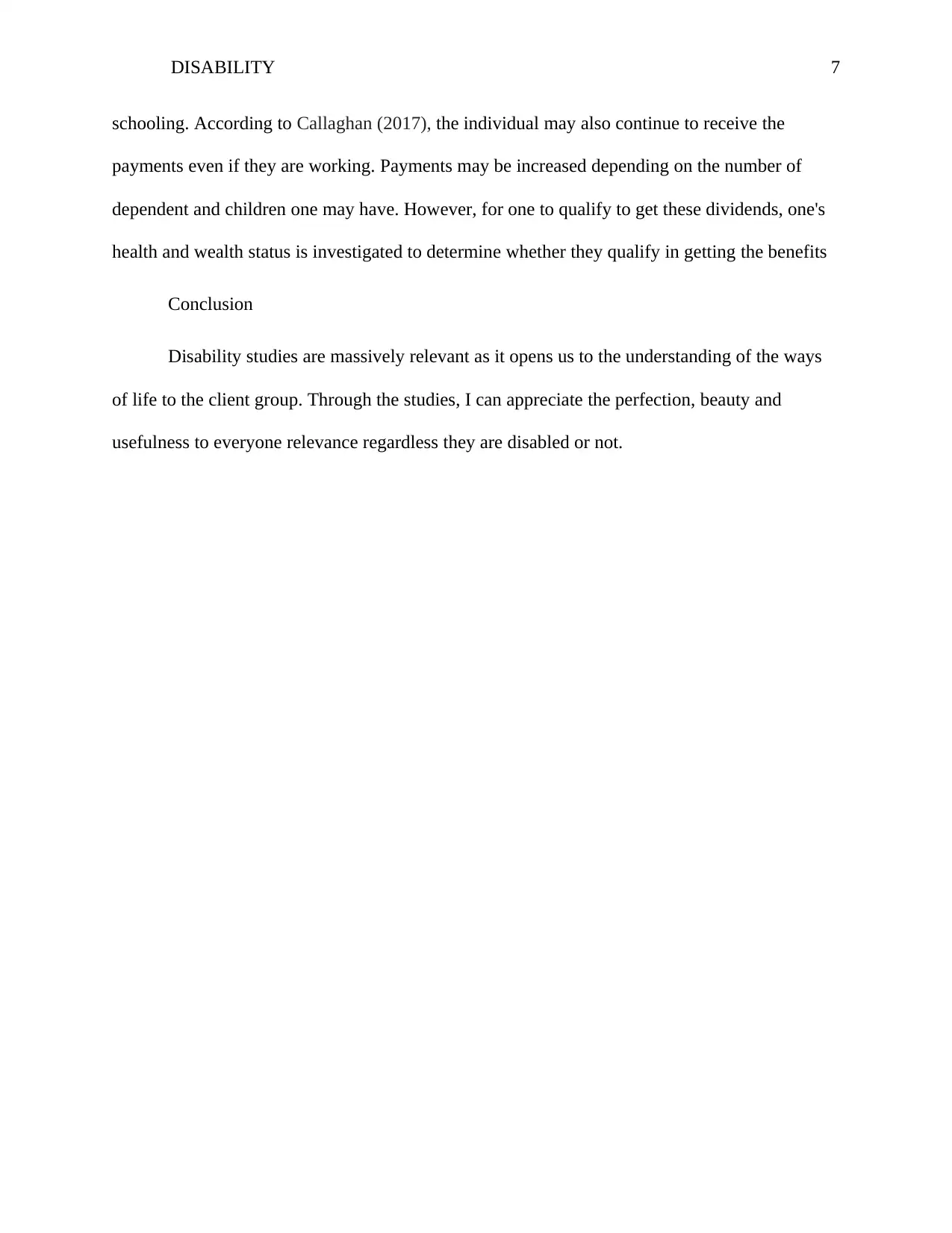
DISABILITY 7
schooling. According to Callaghan (2017), the individual may also continue to receive the
payments even if they are working. Payments may be increased depending on the number of
dependent and children one may have. However, for one to qualify to get these dividends, one's
health and wealth status is investigated to determine whether they qualify in getting the benefits
Conclusion
Disability studies are massively relevant as it opens us to the understanding of the ways
of life to the client group. Through the studies, I can appreciate the perfection, beauty and
usefulness to everyone relevance regardless they are disabled or not.
schooling. According to Callaghan (2017), the individual may also continue to receive the
payments even if they are working. Payments may be increased depending on the number of
dependent and children one may have. However, for one to qualify to get these dividends, one's
health and wealth status is investigated to determine whether they qualify in getting the benefits
Conclusion
Disability studies are massively relevant as it opens us to the understanding of the ways
of life to the client group. Through the studies, I can appreciate the perfection, beauty and
usefulness to everyone relevance regardless they are disabled or not.
Paraphrase This Document
Need a fresh take? Get an instant paraphrase of this document with our AI Paraphraser
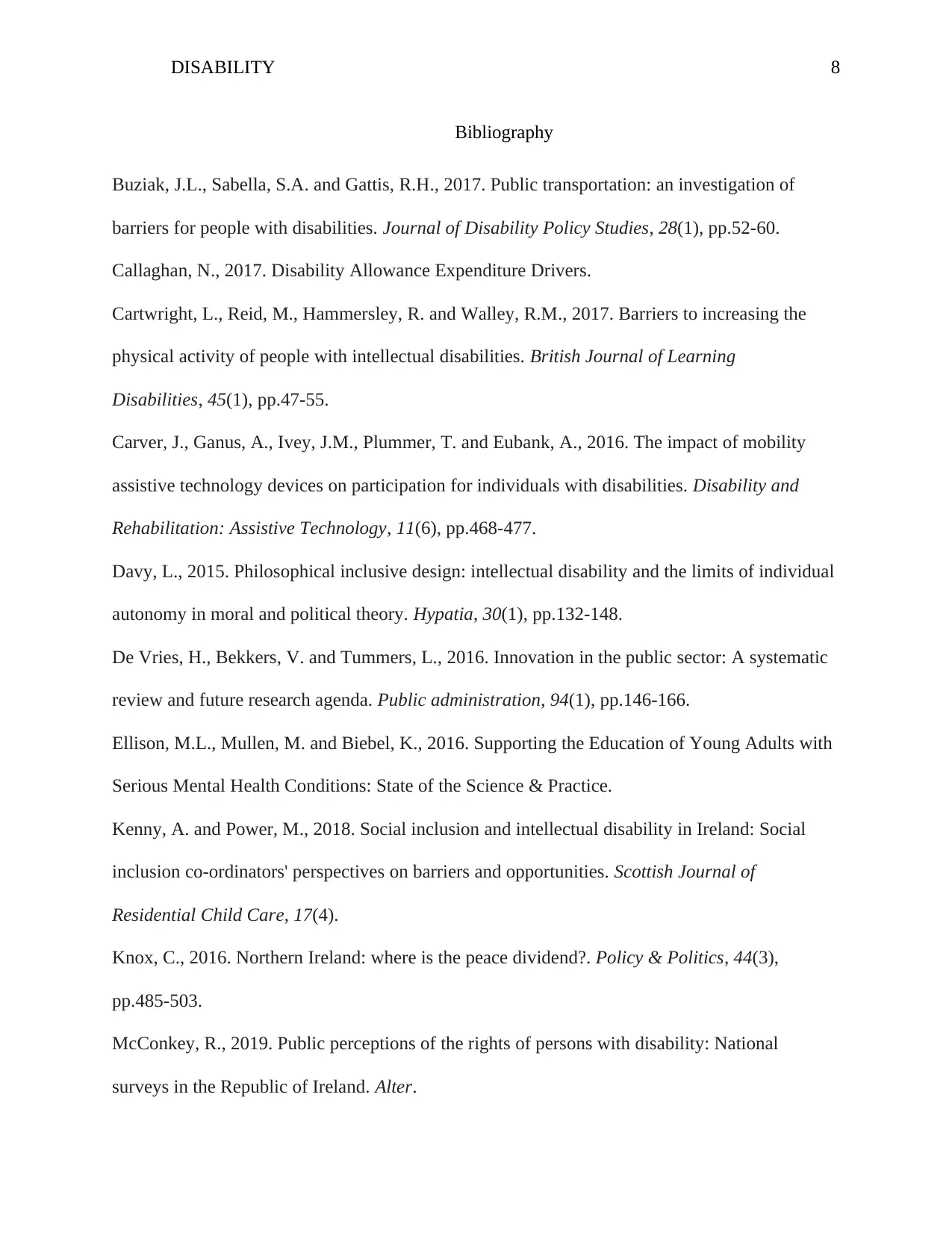
DISABILITY 8
Bibliography
Buziak, J.L., Sabella, S.A. and Gattis, R.H., 2017. Public transportation: an investigation of
barriers for people with disabilities. Journal of Disability Policy Studies, 28(1), pp.52-60.
Callaghan, N., 2017. Disability Allowance Expenditure Drivers.
Cartwright, L., Reid, M., Hammersley, R. and Walley, R.M., 2017. Barriers to increasing the
physical activity of people with intellectual disabilities. British Journal of Learning
Disabilities, 45(1), pp.47-55.
Carver, J., Ganus, A., Ivey, J.M., Plummer, T. and Eubank, A., 2016. The impact of mobility
assistive technology devices on participation for individuals with disabilities. Disability and
Rehabilitation: Assistive Technology, 11(6), pp.468-477.
Davy, L., 2015. Philosophical inclusive design: intellectual disability and the limits of individual
autonomy in moral and political theory. Hypatia, 30(1), pp.132-148.
De Vries, H., Bekkers, V. and Tummers, L., 2016. Innovation in the public sector: A systematic
review and future research agenda. Public administration, 94(1), pp.146-166.
Ellison, M.L., Mullen, M. and Biebel, K., 2016. Supporting the Education of Young Adults with
Serious Mental Health Conditions: State of the Science & Practice.
Kenny, A. and Power, M., 2018. Social inclusion and intellectual disability in Ireland: Social
inclusion co-ordinators' perspectives on barriers and opportunities. Scottish Journal of
Residential Child Care, 17(4).
Knox, C., 2016. Northern Ireland: where is the peace dividend?. Policy & Politics, 44(3),
pp.485-503.
McConkey, R., 2019. Public perceptions of the rights of persons with disability: National
surveys in the Republic of Ireland. Alter.
Bibliography
Buziak, J.L., Sabella, S.A. and Gattis, R.H., 2017. Public transportation: an investigation of
barriers for people with disabilities. Journal of Disability Policy Studies, 28(1), pp.52-60.
Callaghan, N., 2017. Disability Allowance Expenditure Drivers.
Cartwright, L., Reid, M., Hammersley, R. and Walley, R.M., 2017. Barriers to increasing the
physical activity of people with intellectual disabilities. British Journal of Learning
Disabilities, 45(1), pp.47-55.
Carver, J., Ganus, A., Ivey, J.M., Plummer, T. and Eubank, A., 2016. The impact of mobility
assistive technology devices on participation for individuals with disabilities. Disability and
Rehabilitation: Assistive Technology, 11(6), pp.468-477.
Davy, L., 2015. Philosophical inclusive design: intellectual disability and the limits of individual
autonomy in moral and political theory. Hypatia, 30(1), pp.132-148.
De Vries, H., Bekkers, V. and Tummers, L., 2016. Innovation in the public sector: A systematic
review and future research agenda. Public administration, 94(1), pp.146-166.
Ellison, M.L., Mullen, M. and Biebel, K., 2016. Supporting the Education of Young Adults with
Serious Mental Health Conditions: State of the Science & Practice.
Kenny, A. and Power, M., 2018. Social inclusion and intellectual disability in Ireland: Social
inclusion co-ordinators' perspectives on barriers and opportunities. Scottish Journal of
Residential Child Care, 17(4).
Knox, C., 2016. Northern Ireland: where is the peace dividend?. Policy & Politics, 44(3),
pp.485-503.
McConkey, R., 2019. Public perceptions of the rights of persons with disability: National
surveys in the Republic of Ireland. Alter.
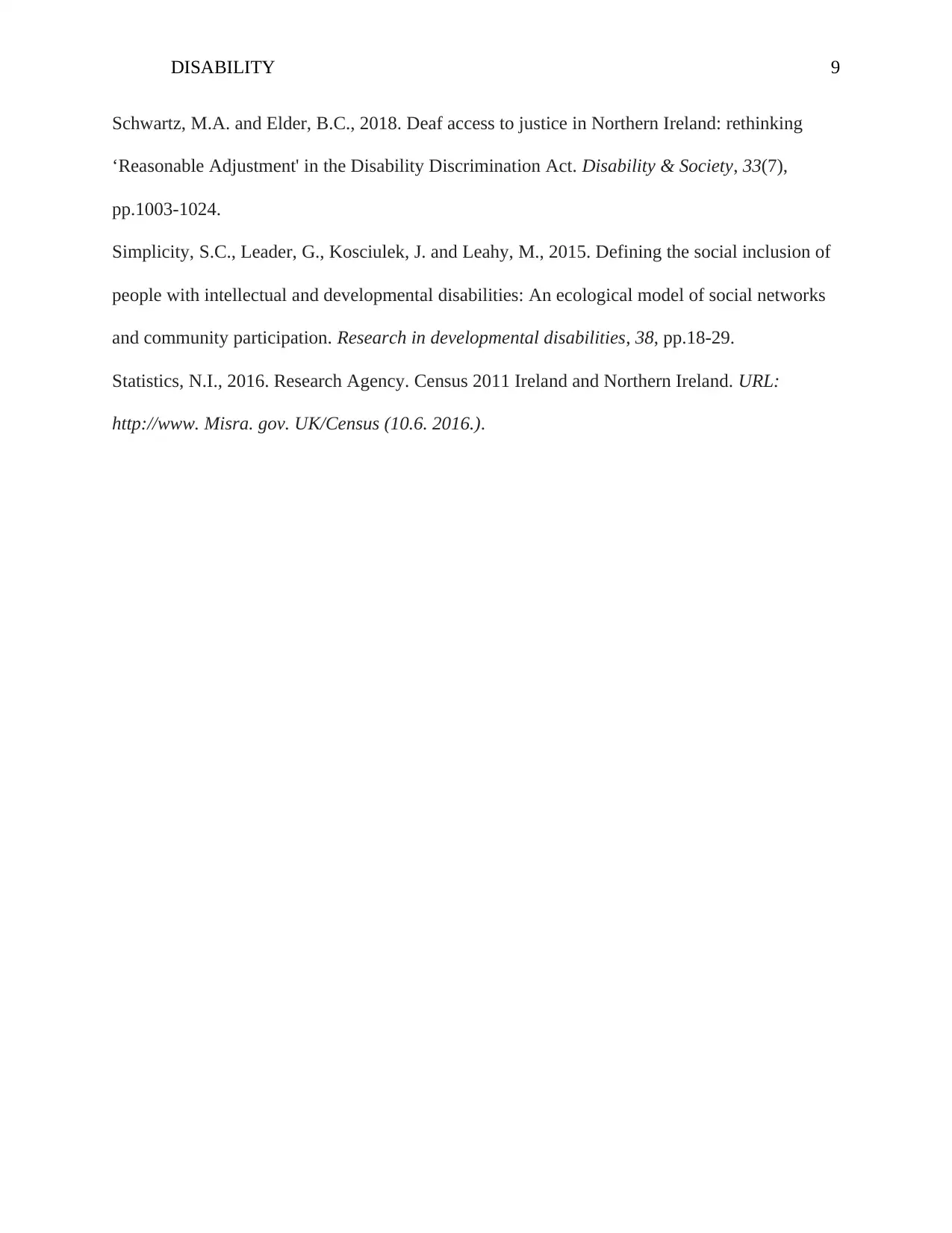
DISABILITY 9
Schwartz, M.A. and Elder, B.C., 2018. Deaf access to justice in Northern Ireland: rethinking
‘Reasonable Adjustment' in the Disability Discrimination Act. Disability & Society, 33(7),
pp.1003-1024.
Simplicity, S.C., Leader, G., Kosciulek, J. and Leahy, M., 2015. Defining the social inclusion of
people with intellectual and developmental disabilities: An ecological model of social networks
and community participation. Research in developmental disabilities, 38, pp.18-29.
Statistics, N.I., 2016. Research Agency. Census 2011 Ireland and Northern Ireland. URL:
http://www. Misra. gov. UK/Census (10.6. 2016.).
Schwartz, M.A. and Elder, B.C., 2018. Deaf access to justice in Northern Ireland: rethinking
‘Reasonable Adjustment' in the Disability Discrimination Act. Disability & Society, 33(7),
pp.1003-1024.
Simplicity, S.C., Leader, G., Kosciulek, J. and Leahy, M., 2015. Defining the social inclusion of
people with intellectual and developmental disabilities: An ecological model of social networks
and community participation. Research in developmental disabilities, 38, pp.18-29.
Statistics, N.I., 2016. Research Agency. Census 2011 Ireland and Northern Ireland. URL:
http://www. Misra. gov. UK/Census (10.6. 2016.).
⊘ This is a preview!⊘
Do you want full access?
Subscribe today to unlock all pages.

Trusted by 1+ million students worldwide
1 out of 9
Related Documents
Your All-in-One AI-Powered Toolkit for Academic Success.
+13062052269
info@desklib.com
Available 24*7 on WhatsApp / Email
![[object Object]](/_next/static/media/star-bottom.7253800d.svg)
Unlock your academic potential
Copyright © 2020–2025 A2Z Services. All Rights Reserved. Developed and managed by ZUCOL.





